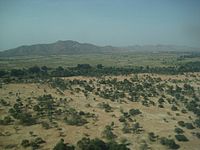
Photo from wikipedia
Abstract Wildlife and livestock have coexisted across East African rangelands for millennia, tracking seasonal forage availability across large landscapes. More recently however, free-ranging movements have been increasingly restricted by land… Click to show full abstract
Abstract Wildlife and livestock have coexisted across East African rangelands for millennia, tracking seasonal forage availability across large landscapes. More recently however, free-ranging movements have been increasingly restricted by land use changes, reducing the ability of livestock and wildlife to access necessary grazing resources, leading to both homogenization and degradation of the rangeland. This in turn has led to losses in productivity of both livestock and wildlife. This study describes wildlife and livestock interactions in response to pasture in one of the few remaining areas of mixed wildlife-livestock use with unrestricted movements. We ask if pastoral management systems can create and maintain spatial and temporal heterogeneity of pasture, through the seasonal movement of livestock. Furthermore, does this heterogeneity create a diverse, productive and resilient assemblage of both domestic and wild ungulates? Our results provide evidence to support the notion that traditional pastoral systems which continue to manage for heterogeneity of pasture can still support not only livestock but also substantial numbers of wildlife. The results highlight the need for wildlife and livestock to retain both mobility and access to both wet and dry season areas to maintain ecosystem resilience and promote coexistence in mixed livestock-wildlife landscapes.
Journal Title: Journal of Arid Environments
Year Published: 2018
Link to full text (if available)
Share on Social Media: Sign Up to like & get
recommendations!